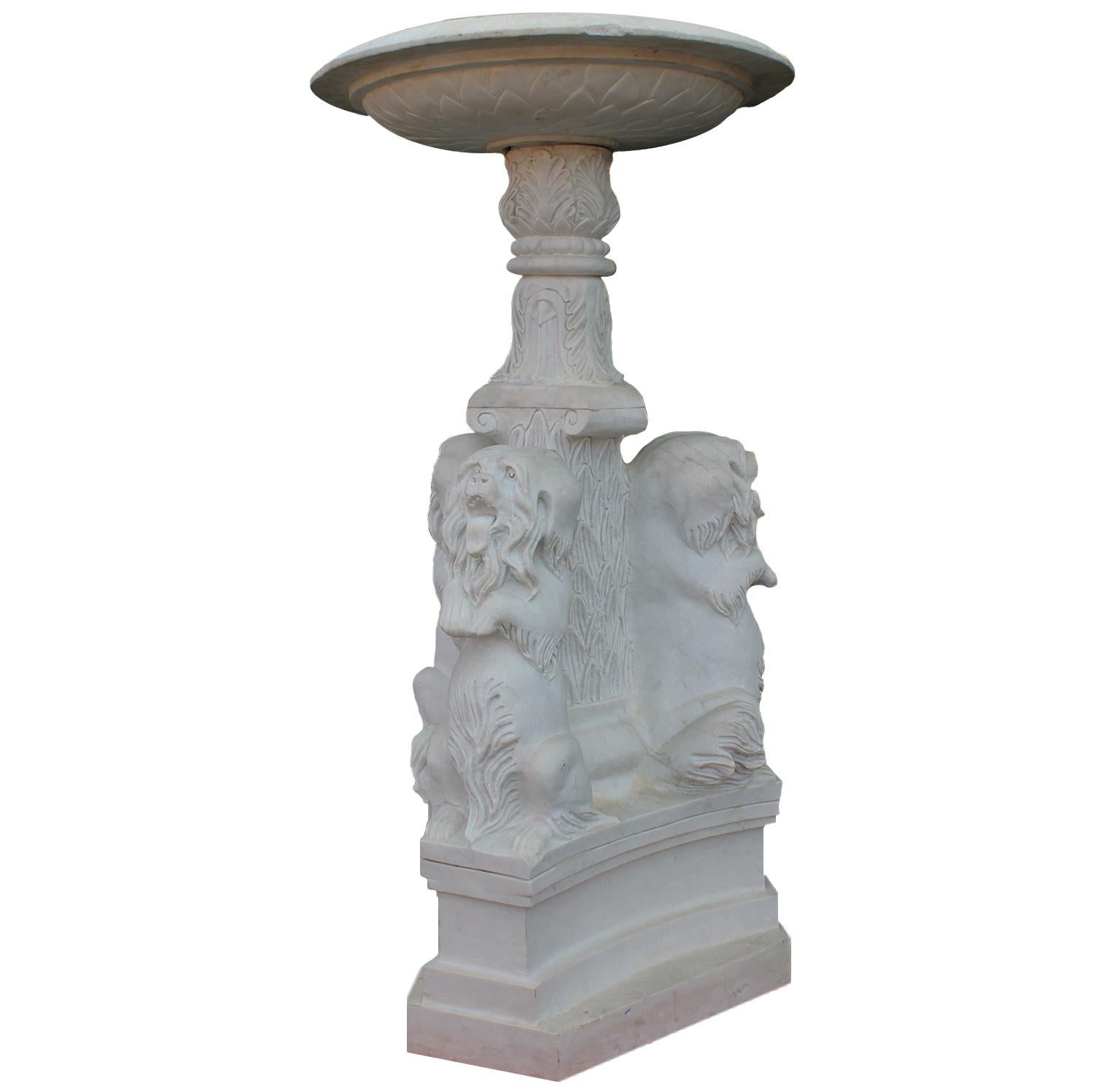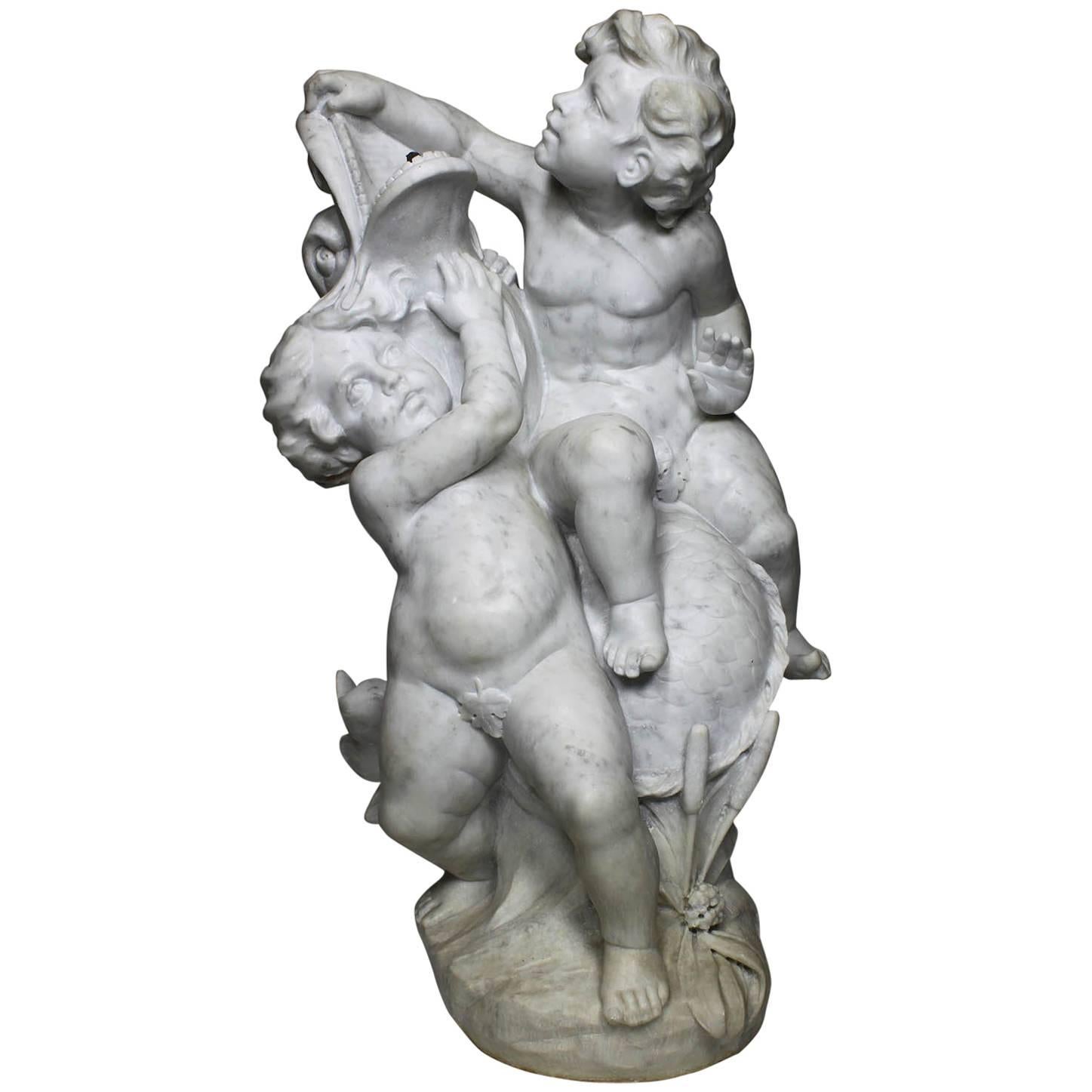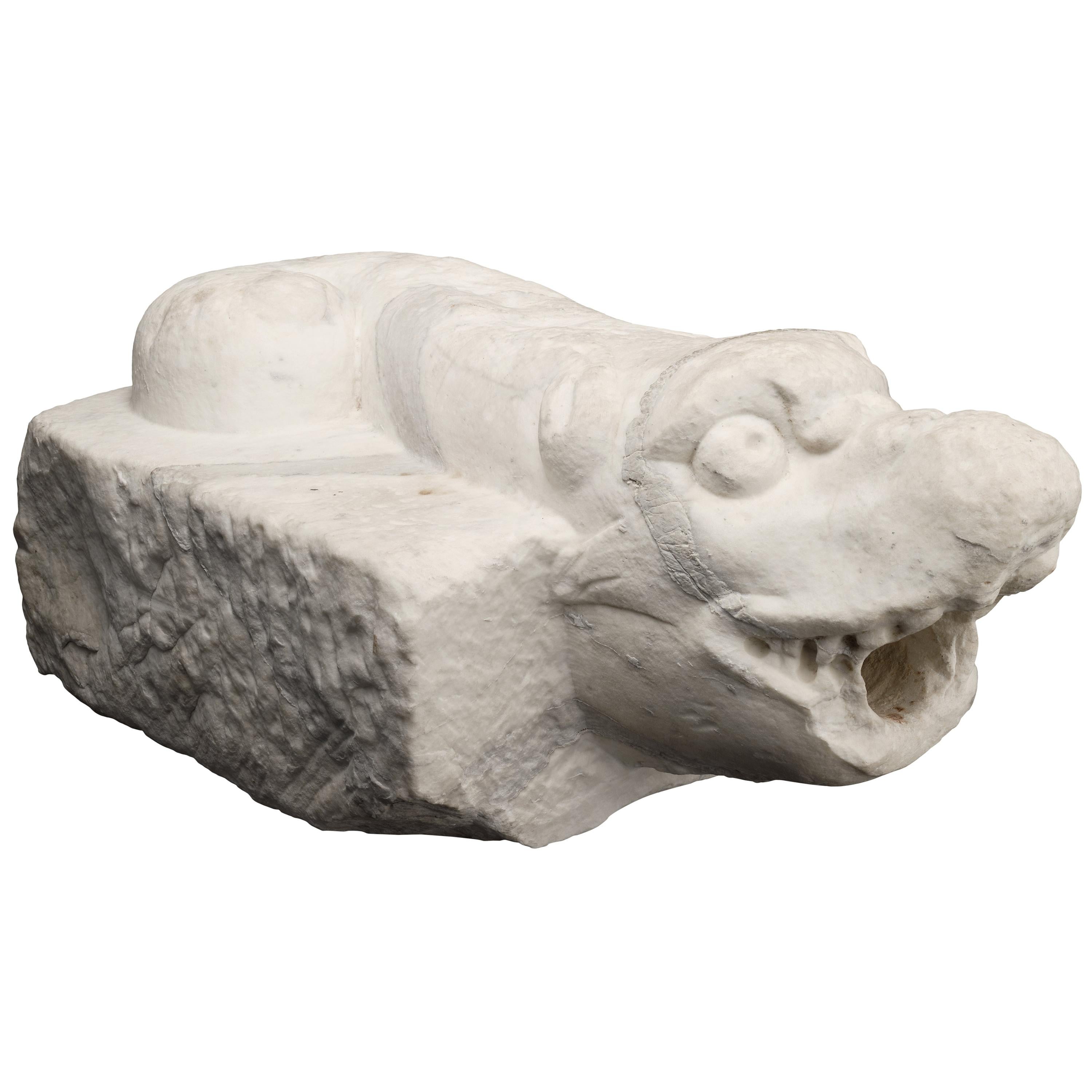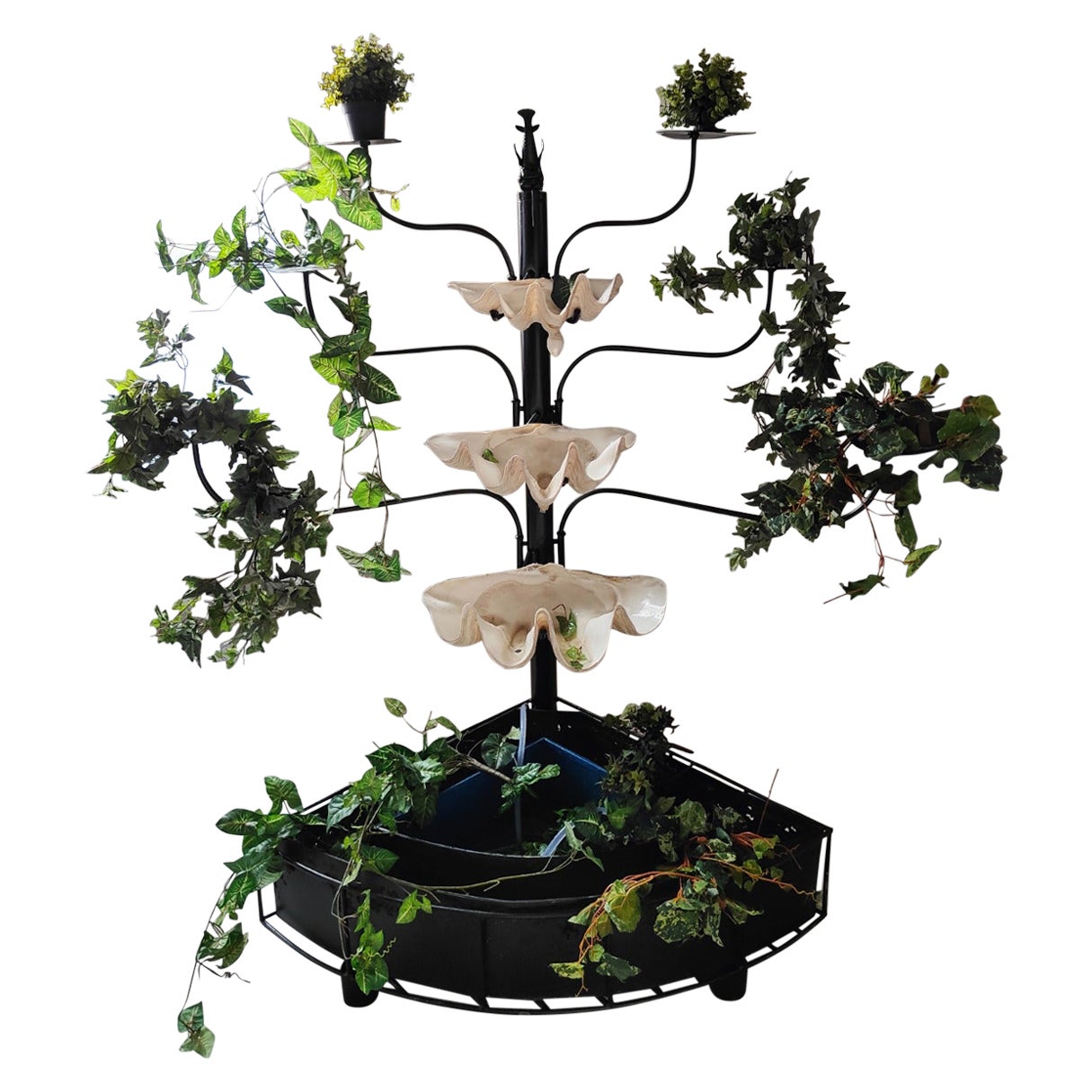Items Similar to 20th Century Italian Stone Fountain Mask
Want more images or videos?
Request additional images or videos from the seller
1 of 17
20th Century Italian Stone Fountain Mask
About the Item
This antique stone mask was probably used in a fountain. It is a very decorative Italian antique object. The mask fits as decorative object on a bureau or placed somewhere else in a living space. This mask depicts a lion head or a moustached male face, it is hard to understand since the lower part of the sculpture is missing. This loss makes this fragment undefined and fascinating.
These fountain masks were designed to be on a wall or pedestal over a basin with the water flowing through the mouth.
Italian origin, dated to early 1900, it comse from a Milanese private collection.
This artwork is shipped from Italy. Under existing legislation, any artwork in Italy created over 70 years ago requires a governative license for export called Belle Arti. The shipping may require additional 2-3 handling weeks to require and get the license according to the final destination of the artwork.
- Dimensions:Height: 10.63 in (27 cm)Width: 10.63 in (27 cm)Depth: 5.52 in (14 cm)
- Style:Classical Roman (In the Style Of)
- Materials and Techniques:
- Place of Origin:
- Period:
- Date of Manufacture:1900
- Condition:Wear consistent with age and use. Minor losses.
- Seller Location:Milan, IT
- Reference Number:
About the Seller
5.0
Vetted Seller
These experienced sellers undergo a comprehensive evaluation by our team of in-house experts.
Established in 1990
1stDibs seller since 2016
164 sales on 1stDibs
Typical response time: 3 hours
Associations
International Confederation of Art and Antique Dealers' Associations
- ShippingRetrieving quote...Ships From: Milan, Italy
- Return PolicyA return for this item may be initiated within 2 days of delivery.
More From This SellerView All
- Italian Pair of Rooster Figures 20th Century Art Nouveau Animalier SculpturesLocated in Milan, ITPair of antique Italian rooster sculptures, hand-made in Italy in the early 20th century, in the Art Nouveau period, inspired to the Animalier style, ...Category
Early 20th Century Italian Art Nouveau Animal Sculptures
MaterialsBronze
- 20th Century Italian Child with Dolls Bronze Sculpture Bambole by ZacchettiBy Renzo ZacchettiLocated in Milan, ITA bronze casting figurative sculpture, a child figure of a lovely little girl with a doll in her arms, entitled Bambole, meaning Dolls, standing on a rectangular green marble basement and dating back to the Italian Fascism...Category
Mid-20th Century Italian Figurative Sculptures
MaterialsMarble, Bronze
- 20th Century Italian Smiling Girl White Marble Bust Sculpture by Bossi AurelioBy Aurelio BossiLocated in Milan, ITA 20th Century Italian white marble bust of a smiling girl, a carved Carrara marble figural sculpture, signed on the base by the Italian artist Aurelio Bossi, 1884-1948, whose sculptures are displayed at Pinacoteca di Brera in Milan, whereas at the Duomo Milan Cathedral there is his Statue of Cardinal Borromeo, while two busts adorn the facade of the chapel of the Niguarda Hospital. This antique female...Category
Early 20th Century Italian Neoclassical Figurative Sculptures
MaterialsCarrara Marble, Stone
- Italian Large Sculpture the Crab Bite Seminude Young Boy De Lotto, 20th CenturyBy Annibale De Lotto 1Located in Milan, ITAnnibale De Lotto Italian bronze fisher boy Sculpture featuring a semi nude young boy figure, a standing fisher boy getting bit by a crab on his f...Category
Early 20th Century Italian Art Nouveau Figurative Sculptures
MaterialsMarble, Bronze
- 20th Century Putti European Pair of Porcelain CherubsLocated in Milan, ITPair of handmade polychrome porcelain sculptures depicting two winged angels, a pair of fine putti, one holding a fruit basket, Allegory of abundance, measuring 10,24 inches / 26 cms...Category
Vintage 1970s European Figurative Sculptures
MaterialsPorcelain
- 20th Century Italian Bronze Bust of a Man with Bow Tie by Dora Bassi, 1970By Dora BassiLocated in Milan, ITAntique Italian bronze sculpture of a smiling man, probably depicting the artist Alessandro Manzoni, with mocking look wearing a bowtie, signed and ...Category
Late 20th Century Italian Figurative Sculptures
MaterialsMarble, Bronze
You May Also Like
- Whimsical English 19th-20th Century White Marble Figural Outdoor Dog FountainLocated in Los Angeles, CAA Whimsical English 19th-20th century white marble figural fountain with dogs fountain. The Baroque Revival six-sided tripod marble base surmounted with three upright seated Yorkshire Terriers resting on a leaf and acanthus center stem, topped with a semi-circular scalloped carved basin...Category
Antique Early 1900s English Baroque Revival Fountains
MaterialsMarble
- A French 19th-20th Century Carved White Marble Fountain Sculpture with ChildrenLocated in Los Angeles, CAA fine and charming French 19th-20th century carved white marble whimsical group sculpture depicting two putti (Children) playing with a dolphin, fitted for use as a fountain, Paris,...Category
Antique Early 1900s French Louis XV Fountains
MaterialsMarble
- 19th Century Large Circular Garden Fountain Neptune, Italian Limestone FountainLocated in West Palm Beach, FLMonumental antique Italian three-tiered garden fountain. Four Cariatidi surround the center base raising the water which spells from the waved shells. The second tier is supported by...Category
Antique Early 19th Century Italian Baroque Fountains
MaterialsLimestone
- Italian Ancient Marble Sculpture Fountain, Late 16th CenturyLocated in Milano, ITSea monster Carrara marble mouth fountain Italy, late 16th century It measures 13.8 x 31.5 x 18.9 in (35 x 80 x 48 cm) State of conservation: some small evident gaps and widespread signs of wear due to outdoor exposure. The gray marks crossing it do not come from restoration, but are rather the natural veins of the marble. This work has some morphological characteristics typically associated with the iconography of the sea monster: an elongated muzzle, sharp teeth, protruding eyes, elongated ears, and a coiled serpent's tail. An in-depth series of studies on artistic depictions of the sea monster attempted to verify how this symbol evolved in antiquity in the European and Mediterranean contexts and how it gradually changed its image and function over time. The iconography itself is mutable and imaginative and its history is rich with cultural and artistic exchange, as well as the overlapping of ideas. This occurred so much that it is difficult to accurately pinpoint the "types" that satisfactorily represent its various developments. However, we can try to summarize the main figures, starting from the biblical Leviathan and the marine creature that swallowed Jonah (in the Christian version, this figure was to become a whale or a "big fish", the “ketos mega”, translation of the Hebrew “dag gadol”). Other specimens ranged from the dragons mentioned in the Iliad (which were winged and had legs) to "ketos” (also from Greek mythology), the terrifying being from whose Latinized name (“cetus”) derives the word "cetacean". See J. Boardman, “Very Like a Whale” - Classical Sea Monsters, in Monsters and Demons in the Ancient and Medieval Worlds, in Papers presented in Honor of Edith Porada, Mainz am Rhein 1987, pp. 73-84). In Italy the monster underwent yet further variations: it can be found in Etruscan art on the front of some sarcophagi representing the companion of souls, while among the Romans we find the “Pistrice” (cited by Plinio in Naturalis Historia PLIN., Nat., II 9, 8 and by Virgilio in Eneide: VERG., Aen., III, 427), which appeared in the shape of a stylized hippocampus or a very large monstrous cetacean and evolved into a hideous being with a dragon's head and long webbed fins. During the Middle Ages, the sea monster was the object of new transformations: at this time, it is often winged, the head is stretched like a crocodile, the front legs are often very sharp fins - sometimes real paws - until the image merges with dragons, the typical figures of medieval visionary spirituality widely found throughout Europe (on this topic and much more, see: Baltrušaitis, J., Il Medioevo fantastico. Antichità ed esotismi nell’arte gotica, Gli Adelphi 1997). In Italy during the 15th and 16th centuries, the revival of classicism - representative of the humanistic and Renaissance periods - led to a different reading of these "creatures". Indeed, the sea monster was also to find widespread use as an isolated decorative motif, especially in numerous fountains and sculptures where dolphins or sea monsters were used as a characterizing element linked to water (on this theme see: Chet Van Duzer, Sea Monsters on Medieval and Renaissance Maps, London, The British library, 2013). From the morphological point of view, the "sea monsters" of this period are mostly depicted as hybrid figures, in which the body of a mythological or real being (a hippocampus, a sea snake, a dolphin), is joined to a head with a rather indistinct appearance. It was usually characterized by large upright ears, an elongated snout, sharp teeth and globular, protruding eyes; a complex and indefinite figure, both from the symbolic point of view and from that of its genesis. The work we are examining is placed as a cross between the medieval sea serpent and the Renaissance dolphin, with stylistic features which recall the snake as often used in heraldry (such as the "snake" depicted in the coat of arms of the Visconti - the lords and then dukes of Milan between 1277 and 1447 - and which, for some, may be derived from the representations of the “Pistrice” that swallowed Jonah). In the search for sources, Renaissance cartography and in particular woodcuts should not be neglected. See for example the monsters of Olaus Magnus, from the editions of the “Historia de gentibus septentrionalibus” (“History of the peoples of the north”) and the natural histories of Conrad Gesner, Ulisse...Category
Antique 16th Century Italian Renaissance Animal Sculptures
MaterialsCarrara Marble
- Modernist 20th Century Wall FountainLocated in Denton, TXTrapezoid shaped granite wall mounted with copper lighted shroud on top and copper catch basin at the bottom. Nice patina on the copper. shipped in pieces ...Category
20th Century North American Modern Fountains
MaterialsGranite, Metal, Copper
- Giant Shell Fountain 20th CenturyBy Europa AntiquesLocated in Madrid, ESGiant shell fountain the structure is in iron and the springs are in authentic giant shell (Tridacna gigas) the arms are mobile and have the shape of a veg...Category
20th Century Spanish Modern Fountains
MaterialsIron
Recently Viewed
View AllMore Ways To Browse
3 Stone European
20th Century Bureau
Italian Face Stone
Classical Mask
Hard Stone Italy
Classical Carved Stone
Mask Carved Antique
Roman Lion
Carved Stone Roman
Antique Stone Lions
Italian Antique Wall Sculpture
Antique Lion Mask
Roman Masks
Classical Carved Head
Antique Bureau 20th Century
Italian Bureau
Ship Wall Sculpture
Antique Classical Pedestal





